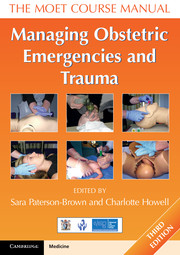Book contents
- Frontmatter
- Dedication
- Contents
- Working Group
- About the authors
- Acknowledgements
- Abbreviations
- Section 1 Introduction
- Section 2 Recognition
- Section 3 Resuscitation
- Section 4 Trauma
- 13 Introduction to trauma
- 14 Domestic abuse
- 15 Thoracic emergencies
- 16 Abdominal trauma in pregnancy
- 17 The unconscious patient
- 18 Spine and spinal cord injuries
- 19 Musculoskeletal trauma
- 20 Burns
- Section 5 Other medical and surgical emergencies
- Section 6 Obstetric emergencies
- Section 7 Triage and transfer
- Section 8 Human issues
- Index
19 - Musculoskeletal trauma
- Frontmatter
- Dedication
- Contents
- Working Group
- About the authors
- Acknowledgements
- Abbreviations
- Section 1 Introduction
- Section 2 Recognition
- Section 3 Resuscitation
- Section 4 Trauma
- 13 Introduction to trauma
- 14 Domestic abuse
- 15 Thoracic emergencies
- 16 Abdominal trauma in pregnancy
- 17 The unconscious patient
- 18 Spine and spinal cord injuries
- 19 Musculoskeletal trauma
- 20 Burns
- Section 5 Other medical and surgical emergencies
- Section 6 Obstetric emergencies
- Section 7 Triage and transfer
- Section 8 Human issues
- Index
Summary
Objectives
On successfully completing this topic, you will be able to:
understand the principles of management of a patient with musculoskeletal trauma
be aware of how to identify and treat life-threatening injuries
be aware of how to identify and treat limb-threatening injuries.
Introduction
Primary survey and resuscitation, secondary survey and definitive care
Within the primary survey, life-threatening injuries are identified and treated. Where musculo skeletal injuries threaten life, it is usually as a circulation problem. There is a need to recognise hypovolaemia, a rapid inspection to identify sites of major bleeding and then measures to stop the bleeding. Beyond the initial resuscitation phase, renal failure can result from traumatic rhabdomyolysis caused by crush injuries; fat embolism is an uncommon, but lethal, complication of long-bone fractures.
It is important to realise that the patient may have multiple injuries. Knowledge of the mechanism of the injury is important in this: a fall from a height can result in cervical spine and other vertebral fractures and/or fractures of the long bones. Some fractures are not easy to detect and are found only after repeated examination. Assistance from an orthopaedic/emergency physician should be summoned immediately.
Life-threatening injuries: primary survey
Life-threatening injuries include:
• major pelvic disruption with haemorrhage
• major arterial haemorrhage
• long-bone fractures
• crush injuries with hyperkalaemic cardiac arrest and later traumatic rhabdomyolysis.
- Type
- Chapter
- Information
- Managing Obstetric Emergencies and TraumaThe MOET Course Manual, pp. 213 - 220Publisher: Cambridge University PressPrint publication year: 2014

